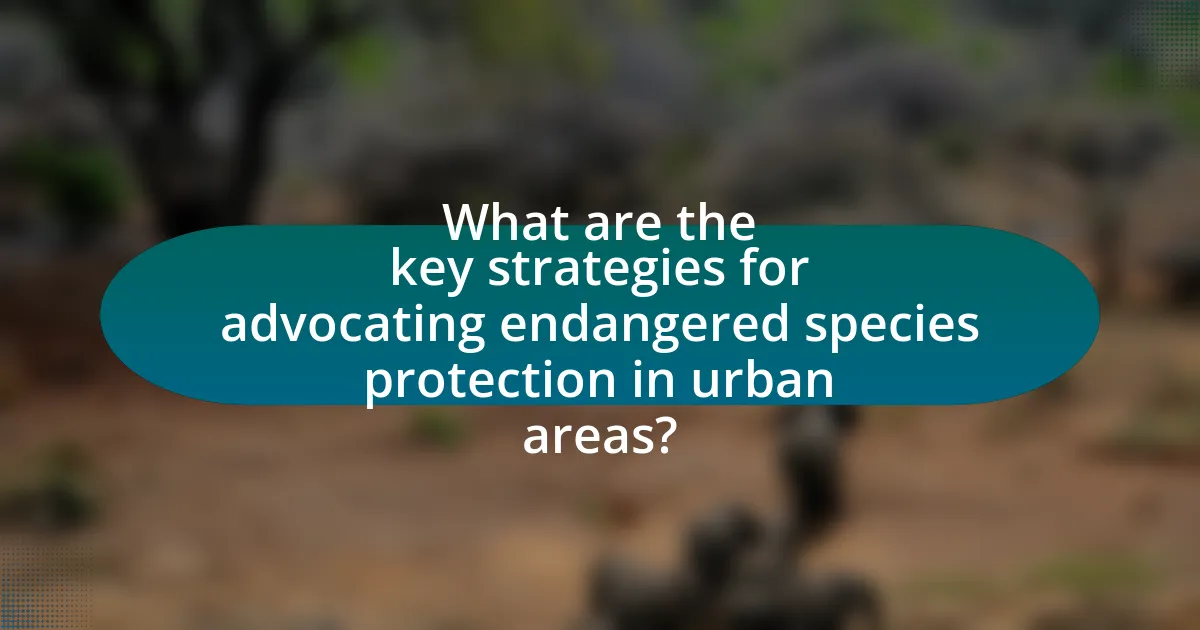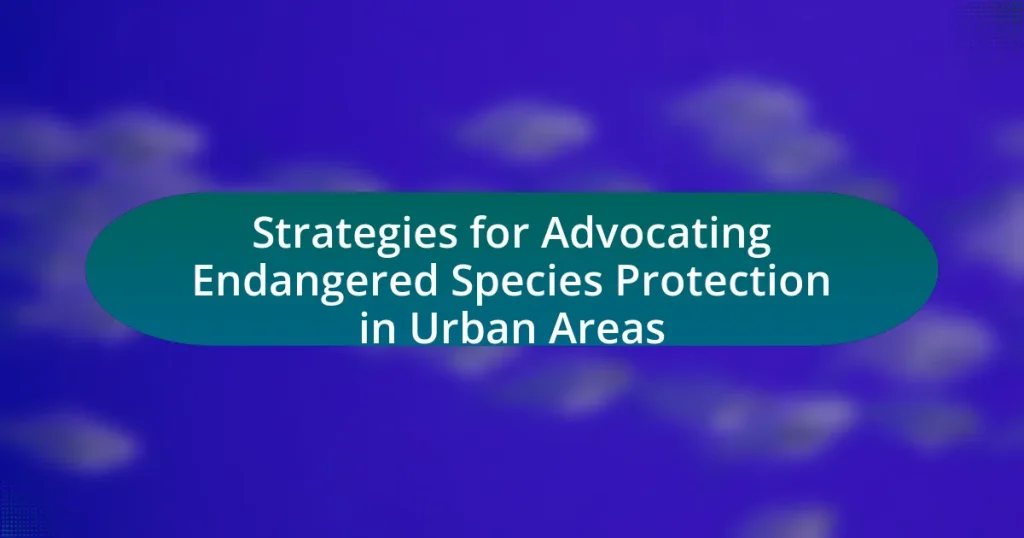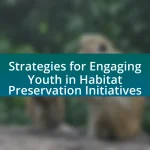The article focuses on strategies for advocating endangered species protection in urban areas, emphasizing community engagement, policy advocacy, habitat restoration, and education initiatives. It highlights the importance of local involvement in conservation efforts, demonstrating how grassroots movements can lead to effective policy changes and increased public support. The article also discusses the role of public awareness, the impact of urban development on wildlife, and the necessity of partnerships with organizations to enhance advocacy efforts. Additionally, it addresses challenges faced by advocates and provides practical steps individuals can take to support endangered species protection.

What are the key strategies for advocating endangered species protection in urban areas?
Key strategies for advocating endangered species protection in urban areas include community engagement, policy advocacy, habitat restoration, and education initiatives. Community engagement fosters local support through awareness campaigns and volunteer opportunities, which can mobilize residents to participate in conservation efforts. Policy advocacy involves working with local governments to create and enforce regulations that protect endangered species and their habitats, such as zoning laws that limit urban sprawl into critical areas. Habitat restoration focuses on rehabilitating degraded environments to support the survival of endangered species, often involving partnerships with environmental organizations. Education initiatives aim to inform the public about the importance of biodiversity and the specific needs of endangered species, which can lead to increased public support for conservation measures. These strategies are supported by studies indicating that community involvement and education significantly enhance conservation outcomes in urban settings.
How can community engagement enhance advocacy efforts?
Community engagement enhances advocacy efforts by fostering a sense of ownership and responsibility among local residents towards endangered species protection. When community members actively participate in advocacy initiatives, they are more likely to understand the issues at stake, share their personal experiences, and mobilize others to take action. Research indicates that grassroots movements, which rely on community involvement, can lead to more effective policy changes and increased public awareness. For instance, a study by the National Audubon Society found that local advocacy campaigns that engaged community members resulted in a 30% increase in support for conservation policies compared to those that did not involve the community. This demonstrates that community engagement not only amplifies voices but also strengthens the overall impact of advocacy efforts.
What methods can be used to involve local residents in conservation initiatives?
To involve local residents in conservation initiatives, community engagement methods such as participatory workshops, volunteer programs, and educational outreach can be effectively utilized. Participatory workshops allow residents to contribute ideas and collaborate on conservation strategies, fostering a sense of ownership and responsibility. Volunteer programs enable residents to actively participate in conservation activities, such as habitat restoration or species monitoring, which can enhance their connection to local ecosystems. Educational outreach, including school programs and public seminars, raises awareness about conservation issues and encourages community involvement. Research indicates that communities engaged in conservation efforts are more likely to support and sustain these initiatives, as seen in the case of the Urban Wildlife Conservation Program, which successfully mobilized local residents in various cities to protect urban biodiversity.
How does public awareness impact endangered species protection?
Public awareness significantly enhances endangered species protection by fostering community engagement and support for conservation initiatives. When the public is informed about the plight of endangered species, they are more likely to participate in advocacy efforts, such as supporting legislation aimed at habitat preservation or contributing to conservation organizations. For instance, a study published in the journal “Conservation Biology” found that increased public awareness campaigns led to a 30% rise in donations to wildlife protection organizations, directly correlating with improved funding for endangered species programs. This demonstrates that informed communities can mobilize resources and influence policy changes that benefit endangered species.
What role do policy changes play in protecting endangered species?
Policy changes play a crucial role in protecting endangered species by establishing legal frameworks that regulate human activities impacting their habitats. These changes can lead to the creation of protected areas, restrictions on hunting and trade, and the implementation of conservation programs. For instance, the Endangered Species Act in the United States has been instrumental in recovering species like the American bald eagle, which was removed from the endangered species list due to successful policy enforcement and habitat protection measures. Such policies not only provide immediate protections but also promote long-term conservation strategies that address the root causes of species decline, ensuring sustainable ecosystems.
How can advocates influence local government policies?
Advocates can influence local government policies by mobilizing community support and presenting data-driven arguments to decision-makers. By organizing campaigns, conducting outreach, and engaging in public forums, advocates can raise awareness about endangered species issues, thereby creating pressure on local governments to adopt protective measures. For instance, studies have shown that community engagement can lead to increased policy responsiveness, as seen in the successful implementation of urban wildlife corridors in cities like Los Angeles, where advocacy groups collaborated with local officials to enhance biodiversity.
What are effective lobbying techniques for conservationists?
Effective lobbying techniques for conservationists include building coalitions, utilizing data-driven arguments, and engaging in grassroots mobilization. Building coalitions with other environmental organizations enhances influence and resources, as seen in successful campaigns like the coalition for the Endangered Species Act, which united diverse groups to advocate for stronger protections. Utilizing data-driven arguments, such as presenting statistics on biodiversity loss, can persuade policymakers by highlighting the urgency of conservation efforts; for instance, studies show that urban areas can lose up to 50% of their native species due to habitat destruction. Grassroots mobilization, including organizing community events and leveraging social media, empowers local constituents to voice their concerns, exemplified by the success of campaigns like the “Save the Bees” movement, which rallied public support for pollinator protection policies.
How can partnerships with organizations strengthen advocacy efforts?
Partnerships with organizations can strengthen advocacy efforts by leveraging combined resources, expertise, and networks to amplify messaging and outreach. Collaborative initiatives allow for a broader reach, as organizations can share their platforms and engage diverse audiences, increasing public awareness and support for endangered species protection. For example, a partnership between environmental NGOs and local community groups can mobilize volunteers for conservation projects, enhancing community involvement and fostering a sense of ownership over local ecosystems. Additionally, joint advocacy campaigns can pool funding and research capabilities, leading to more effective policy influence and legislative change, as seen in successful collaborations like the Endangered Species Coalition, which unites various stakeholders to advocate for stronger protections.
What types of organizations should be targeted for partnerships?
Non-profit organizations focused on environmental conservation, wildlife protection agencies, and local community groups should be targeted for partnerships. These organizations often have established networks and resources dedicated to the advocacy of endangered species, making them valuable allies in urban areas. For instance, the World Wildlife Fund and local Audubon societies actively engage in initiatives that promote biodiversity and habitat preservation, which aligns with the goals of protecting endangered species. Collaborating with these entities can enhance outreach efforts, increase funding opportunities, and leverage expertise in conservation strategies.
How can collaboration enhance resource sharing and outreach?
Collaboration enhances resource sharing and outreach by pooling expertise, funding, and networks among various stakeholders. When organizations, government agencies, and community groups work together, they can combine their resources to create more comprehensive and effective outreach programs. For instance, a study by the National Oceanic and Atmospheric Administration (NOAA) found that collaborative efforts in conservation initiatives led to a 30% increase in community engagement and resource mobilization. This demonstrates that collaboration not only maximizes available resources but also amplifies the impact of outreach efforts, making them more effective in advocating for endangered species protection in urban areas.

What challenges do advocates face in urban areas?
Advocates face significant challenges in urban areas, primarily due to competing land use priorities and limited resources. Urban development often prioritizes economic growth and infrastructure over environmental conservation, leading to habitat destruction for endangered species. Additionally, advocates frequently encounter bureaucratic hurdles, such as complex zoning laws and regulatory processes that can delay or obstruct conservation efforts. A study by the Urban Institute highlights that urban areas are home to over 80% of the U.S. population, intensifying the competition for land and resources, which complicates advocacy efforts for endangered species protection.
How does urban development impact endangered species?
Urban development negatively impacts endangered species by destroying their habitats, leading to population declines and increased vulnerability. As cities expand, natural landscapes are converted into residential, commercial, and industrial areas, which fragment ecosystems and reduce the availability of essential resources such as food and shelter. For instance, a study published in the journal “Biological Conservation” found that urbanization is a significant driver of habitat loss for species like the California tiger salamander, which has seen its population decrease by over 90% due to urban sprawl. Additionally, urban areas often introduce pollution and invasive species, further threatening the survival of endangered species.
What specific threats do urban environments pose to wildlife?
Urban environments pose specific threats to wildlife, including habitat loss, pollution, and increased human-wildlife conflict. Habitat loss occurs as urban development replaces natural landscapes, reducing the space available for wildlife to live and thrive. Pollution from vehicles, industrial activities, and waste can contaminate air, water, and soil, adversely affecting the health of wildlife populations. Additionally, urban areas often lead to increased encounters between humans and wildlife, resulting in conflicts that can harm animals, such as road fatalities or the displacement of species. These threats are supported by studies indicating that urbanization significantly reduces biodiversity and disrupts ecosystems, highlighting the urgent need for protective strategies for endangered species in these environments.
How can urban planning be adjusted to mitigate these threats?
Urban planning can be adjusted to mitigate threats to endangered species by incorporating biodiversity considerations into land-use policies and development regulations. This approach includes creating green corridors, preserving natural habitats, and implementing zoning laws that protect critical ecosystems. For instance, studies show that urban green spaces can enhance biodiversity and provide essential habitats for various species, thereby reducing habitat fragmentation. Additionally, integrating environmental impact assessments in the planning process ensures that potential threats to endangered species are identified and addressed before development occurs. These strategies collectively contribute to a more sustainable urban environment that supports both human and wildlife populations.
What are the common misconceptions about endangered species in cities?
Common misconceptions about endangered species in cities include the belief that urban environments cannot support biodiversity and that endangered species are only found in remote areas. In reality, many endangered species adapt to urban settings, utilizing parks, gardens, and green spaces for habitat. For instance, studies have shown that urban areas can host diverse wildlife, including species like peregrine falcons and red-tailed hawks, which thrive in city landscapes. Additionally, the misconception that urbanization leads to the complete loss of species overlooks the fact that some species can coexist with human development, as evidenced by the presence of endangered species in urban reserves and protected areas.
How can education address these misconceptions?
Education can address misconceptions about endangered species protection in urban areas by providing accurate information and fostering awareness. Through targeted educational programs, workshops, and community outreach, individuals can learn about the ecological importance of endangered species and the role urban environments play in their survival. Research indicates that educational initiatives, such as those implemented by organizations like the National Wildlife Federation, have successfully increased public understanding and engagement in conservation efforts. By dispelling myths and promoting factual knowledge, education empowers communities to advocate effectively for the protection of endangered species within urban settings.
What role does media play in shaping public perception?
Media plays a crucial role in shaping public perception by influencing how information is presented and consumed. Through various platforms, media disseminates narratives that can highlight the importance of endangered species protection, thereby affecting public awareness and attitudes. For instance, studies show that media coverage of environmental issues can lead to increased public concern and support for conservation efforts, as evidenced by the rise in donations to wildlife organizations following high-profile media campaigns. This demonstrates that the framing of information in media can significantly impact public engagement and advocacy for endangered species in urban areas.

What practical steps can individuals take to support endangered species protection?
Individuals can support endangered species protection by participating in local conservation efforts, such as volunteering with wildlife organizations or engaging in habitat restoration projects. These actions directly contribute to the preservation of ecosystems that endangered species rely on. For instance, the World Wildlife Fund reports that community involvement in habitat restoration can significantly enhance biodiversity and improve the chances of survival for threatened species. Additionally, individuals can advocate for policy changes by contacting local representatives to promote legislation aimed at protecting endangered species and their habitats. This approach has been shown to influence conservation policies effectively, as evidenced by the success of grassroots campaigns in various regions. Furthermore, individuals can reduce their ecological footprint by adopting sustainable practices, such as minimizing plastic use and supporting eco-friendly products, which helps mitigate the threats posed to endangered species by pollution and habitat destruction.
How can residents contribute to local conservation efforts?
Residents can contribute to local conservation efforts by participating in community clean-up events, supporting local wildlife organizations, and advocating for sustainable practices. Engaging in clean-up activities helps remove litter from natural habitats, which directly benefits local ecosystems. Supporting wildlife organizations can involve volunteering time or donating resources, which strengthens conservation initiatives. Additionally, residents can advocate for sustainable practices by promoting policies that protect endangered species and their habitats, as evidenced by studies showing that community involvement significantly enhances conservation outcomes.
What are some volunteer opportunities available for individuals?
Volunteer opportunities for individuals include participating in local wildlife conservation projects, joining community clean-up events, and assisting with educational programs focused on endangered species. Organizations such as the National Audubon Society and local wildlife rehabilitation centers often seek volunteers to help with habitat restoration and species monitoring. According to the National Park Service, engaging in these activities not only supports biodiversity but also fosters community awareness and involvement in conservation efforts.
How can people advocate for policy changes at the grassroots level?
People can advocate for policy changes at the grassroots level by organizing community meetings to raise awareness and gather support for specific issues. Engaging local residents through educational campaigns about endangered species and their habitats can mobilize public interest and action. Additionally, forming coalitions with local environmental organizations enhances collective influence, as demonstrated by the success of groups like the Sierra Club in advocating for policy reforms. Utilizing social media platforms to share information and rally support can amplify grassroots efforts, as evidenced by campaigns that have gained traction and led to legislative changes.
What resources are available for learning about endangered species protection?
Resources for learning about endangered species protection include government websites, educational institutions, and non-profit organizations. The U.S. Fish and Wildlife Service provides comprehensive information on endangered species through its website, detailing laws, conservation efforts, and species profiles. Additionally, universities often offer courses and research programs focused on conservation biology and ecology, which can enhance understanding of species protection. Non-profit organizations like the World Wildlife Fund and the Nature Conservancy also provide educational materials, reports, and advocacy tools aimed at raising awareness and promoting action for endangered species. These resources collectively support informed advocacy and action for species protection in urban areas.
Where can individuals find reliable information on local species at risk?
Individuals can find reliable information on local species at risk through government wildlife agencies, conservation organizations, and academic institutions. For example, the U.S. Fish and Wildlife Service provides detailed listings and recovery plans for endangered species, while organizations like the World Wildlife Fund offer resources on local biodiversity. Additionally, universities often conduct research on regional species and publish findings that can be accessed through their websites or libraries. These sources are credible and regularly updated, ensuring that the information is accurate and relevant to local conservation efforts.
What tools can help in organizing community advocacy efforts?
Digital platforms such as social media, email marketing tools, and community organizing software can significantly aid in organizing community advocacy efforts. Social media platforms like Facebook and Twitter facilitate outreach and engagement, allowing advocates to share information and mobilize supporters quickly. Email marketing tools, such as Mailchimp, enable the distribution of newsletters and updates to keep the community informed and involved. Additionally, community organizing software like Mobilize or NationBuilder provides features for event management, volunteer coordination, and donor tracking, enhancing the overall effectiveness of advocacy campaigns. These tools collectively streamline communication, foster community engagement, and improve organizational efficiency, which are essential for successful advocacy efforts.


